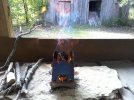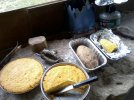Codger_64
Moderator
- Joined
- Oct 8, 2004
- Messages
- 62,324
I've been looking for a beter way to cook baked foods in camp. Yeah, I can fry them or use a reflector made of foil, but I really, really want to be able to bake. Since I canoe, I can use a cast iron dutch oven, but that is a lot of trouble with prpared fires, cleanup and all. After a bit of searching, I found a real oven-like oven that collapses. I used to have one of the old Coleman camp stove ovens, but it got stolen along with my canoe about four years ago, and I really wanted something smaller and lighter. Something that could be used with my Max Mini gas stove, my Emberlit twig stove or even coals from a fire. I found the Bemco oven on the Backpacker Magazine site forum and just ordered one from the 'bay.
I was hesitant to pull the trigger because the oven requires a stove with a remote cannister. It just gets too hot in the lower chamber for the safe location of a gas cartridge there. Brunton used to make a kit to relocate the cannister, but it is my understanding they were discontinued several years ago. And buying a new stove with remote cannister does not fit my plans or budget.
Another hesitation was that the Bemco was not compatable with my Emberlit for several reasons. The oven did not have a sealed diffuser plate (oven floor) and using my Emberlit meant flame and smoke going into the cooking chamber. Smoked biscuits anyone? Another problem is the low clearance between the diffuser plate and the ground, not leaving room for the Emberlit's height.
Here are the manufacturer's stock photos:
Oven packed for carry. Relatively small package, 1 1/2" thick, 7" wide and 12" tall. Weight stated as 24 ounces.

Assembled oven. 7"x7"x 12" tall. Two wire racks so that both included 6" pans can bake together. You can see the recommended remote cannister stove and hinged drop down oven door.

The unit includes a removable temp guage... a detail that helps immensely with baking and a vast improvement over a dutch oven. There is also an adjustable top vent to help control the temp, besides controling the burner volume.

The carry weight, just like most given tent weights, is slightly more than the given for the oven itself as it includes a spondonicle (pot gripper), the two 6" pans (1-shallow and 1-deep), and a baking guide/instruction booklet with recipes. Both weights include the straps and thermometer.
This is still not that light, but I think I can overcome the shortfalls for using my two stoves with it. I will be on the lookout for the Brunton remote tank/stove stand kit so that I can use my existing gas stove with it.
A Youtube video shows the oven being fueled with campfire coals piled underneath. This tells me that if I wait until my Emberlit has burned down to a healthy bed of coals, or if I fill it with campfire coals, it will work just fine... height problem not-withstanding. I have an idea of overcoming that by using four slotted pipe legs to raise the oven to the needed height. I don't think the stove would be stable enough if I simply set it on top of the Emberlit. It would tilt or slide and fall off, particularly while opening the door and moving pans loaded with food.
I'll report back when the oven arrives and I've experimented with it some. It seems to be too heavy to be attractive to backpackers, but for canoe camping, not bad at all. The ability to really bake bread, pizza, biscuits and deserts has some value, IMHO.
I was hesitant to pull the trigger because the oven requires a stove with a remote cannister. It just gets too hot in the lower chamber for the safe location of a gas cartridge there. Brunton used to make a kit to relocate the cannister, but it is my understanding they were discontinued several years ago. And buying a new stove with remote cannister does not fit my plans or budget.
Another hesitation was that the Bemco was not compatable with my Emberlit for several reasons. The oven did not have a sealed diffuser plate (oven floor) and using my Emberlit meant flame and smoke going into the cooking chamber. Smoked biscuits anyone? Another problem is the low clearance between the diffuser plate and the ground, not leaving room for the Emberlit's height.
Here are the manufacturer's stock photos:
Oven packed for carry. Relatively small package, 1 1/2" thick, 7" wide and 12" tall. Weight stated as 24 ounces.

Assembled oven. 7"x7"x 12" tall. Two wire racks so that both included 6" pans can bake together. You can see the recommended remote cannister stove and hinged drop down oven door.

The unit includes a removable temp guage... a detail that helps immensely with baking and a vast improvement over a dutch oven. There is also an adjustable top vent to help control the temp, besides controling the burner volume.

The carry weight, just like most given tent weights, is slightly more than the given for the oven itself as it includes a spondonicle (pot gripper), the two 6" pans (1-shallow and 1-deep), and a baking guide/instruction booklet with recipes. Both weights include the straps and thermometer.
This is still not that light, but I think I can overcome the shortfalls for using my two stoves with it. I will be on the lookout for the Brunton remote tank/stove stand kit so that I can use my existing gas stove with it.
A Youtube video shows the oven being fueled with campfire coals piled underneath. This tells me that if I wait until my Emberlit has burned down to a healthy bed of coals, or if I fill it with campfire coals, it will work just fine... height problem not-withstanding. I have an idea of overcoming that by using four slotted pipe legs to raise the oven to the needed height. I don't think the stove would be stable enough if I simply set it on top of the Emberlit. It would tilt or slide and fall off, particularly while opening the door and moving pans loaded with food.
I'll report back when the oven arrives and I've experimented with it some. It seems to be too heavy to be attractive to backpackers, but for canoe camping, not bad at all. The ability to really bake bread, pizza, biscuits and deserts has some value, IMHO.




